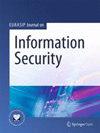元数据过滤,用户友好的集中生物识别认证
IF 2.5
Q2 COMPUTER SCIENCE, INFORMATION SYSTEMS
引用次数: 5
摘要
到目前为止,商业用途的生物识别身份验证主要用于本地设备解锁用例,但也有很大的机会将其用于远程登录等中央身份验证。然而,目前许多生物识别传感器,如移动指纹传感器,由于安全原因,错误接受率(FAR)太大,不允许在较大的用户群体中用于集中识别目的。避免此FAR问题的一种直接方法是请求用户唯一标识符(如设备标识符),或者要求用户在进行生物识别匹配之前输入唯一的用户ID。当用户希望在以前未使用的泛型设备上进行身份验证时,设备标识符的使用不起作用。此外,要求用户在每次登录时都输入唯一的用户ID,这一点都不方便用户使用。为了避免这个问题,我们在本文中研究了一种替代的,最用户友好的方法,将识别与使用元数据过滤的基于生物特征的身份验证相结合。对所采用的方法进行了评估,使用瑞典人口的现实模拟来评估拟议系统的可行性。结果表明,元数据过滤与传统的基于生物特征的匹配相结合,确实是一种强大的工具,可以为大型用户群提供可靠的、用户友好的中央认证服务。本文章由计算机程序翻译,如有差异,请以英文原文为准。
Metadata filtering for user-friendly centralized biometric authentication
While biometric authentication for commercial use so far mainly has been used for local device unlock use cases, there are great opportunities for using it also for central authentication such as for remote login. However, many current biometric sensors like for instance mobile fingerprint sensors have too large false acceptance rate (FAR) not allowing them, for security reasons, to be used in larger user group for central identification purposes. A straightforward way to avoid this FAR problem is to either request a user unique identifier such as a device identifier or require the user to enter a unique user ID prior to making the biometric matching. Usage of a device identifier does not work when a user desires to authenticate on a previously unused device of a generic type. Furthermore, requiring the user at each login occasion to enter a unique user ID, is not at all user-friendly. To avoid this problem, we in this paper investigate an alternative, most user-friendly approach, for identification in combination with biometric-based authentication using metadata filtering. An evaluation of the adopted approach is carried out using realistic simulations of the Swedish population to assess the feasibility of the proposed system. The results show that metadata filtering in combination with traditional biometric-based matching is indeed a powerful tool for providing reliable, and user-friendly, central authentication services for large user groups.
求助全文
通过发布文献求助,成功后即可免费获取论文全文。
去求助
来源期刊

EURASIP Journal on Information Security
COMPUTER SCIENCE, INFORMATION SYSTEMS-
CiteScore
8.80
自引率
0.00%
发文量
6
审稿时长
13 weeks
期刊介绍:
The overall goal of the EURASIP Journal on Information Security, sponsored by the European Association for Signal Processing (EURASIP), is to bring together researchers and practitioners dealing with the general field of information security, with a particular emphasis on the use of signal processing tools in adversarial environments. As such, it addresses all works whereby security is achieved through a combination of techniques from cryptography, computer security, machine learning and multimedia signal processing. Application domains lie, for example, in secure storage, retrieval and tracking of multimedia data, secure outsourcing of computations, forgery detection of multimedia data, or secure use of biometrics. The journal also welcomes survey papers that give the reader a gentle introduction to one of the topics covered as well as papers that report large-scale experimental evaluations of existing techniques. Pure cryptographic papers are outside the scope of the journal. Topics relevant to the journal include, but are not limited to: • Multimedia security primitives (such digital watermarking, perceptual hashing, multimedia authentictaion) • Steganography and Steganalysis • Fingerprinting and traitor tracing • Joint signal processing and encryption, signal processing in the encrypted domain, applied cryptography • Biometrics (fusion, multimodal biometrics, protocols, security issues) • Digital forensics • Multimedia signal processing approaches tailored towards adversarial environments • Machine learning in adversarial environments • Digital Rights Management • Network security (such as physical layer security, intrusion detection) • Hardware security, Physical Unclonable Functions • Privacy-Enhancing Technologies for multimedia data • Private data analysis, security in outsourced computations, cloud privacy
 求助内容:
求助内容: 应助结果提醒方式:
应助结果提醒方式:


